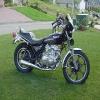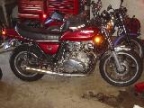- Posts: 47
- Thank you received: 1
tire pressure question
- LP440
-
 Topic Author
Topic Author
- Offline
- User
Please Log in or Create an account to join the conversation.
- OKC_Kent
-

- Offline
- User
- Posts: 1718
- Thank you received: 20
Oklahoma City, OK
78 KZ650 B2 82,000+ miles
Please Log in or Create an account to join the conversation.
- apeman
-

- Offline
- User
- Posts: 346
- Thank you received: 3
You can find one entire thread here:
www.kzrider.com/forum/viewthread.php?tid=22469
But for ease of reference, my comments are repeated as follows:
Go to the tire manufacturer's website for your tires...
...and they will tell you the correct operating tire pressure range. DO NOT use the original Kawasaki specs, as those were for the old style tires used on the bike when it was new. More modern tires have a softer, and stickier, tread rubber. That means a lot of the "flex" needed in the tire is in the tread rubber, rather than in the casing and sidewalls, as in the old days. Therefore, the newer tires have a higher recommended operating pressure range than the old style tires. The casing is therefore a little stiffer, but the rubber is softer, so it works, better than the old style.
From looking at the Bridgestone website (for my Spitfires), I run 29 psi front, and 33 psi rear. It rides straight and steady.
I think some of you are misreading the MSGroup info...
I looked at that article, and note that they are not clear about the "maximum" tire pressure recomendation. The problem is there are TWO maximums.
First there is the manufacturer's recommended operating range. It generally says something like "operating range 26-34 psi", or there may be a chart which corrolates the recommended operating pressure with hi/low speed riding, and hi/low load on the bike. If you run at highway speeds, and with a significant load, then you should inflate toward the upper end of this range. If you are a skinney 110 lb. teenager who only cruises around town, and never on the highway, then you can operate toward the lower end of that range.
There is also a "maximum inflation pressure". That is NOT the operating pressure, it is instead the maximum pressure that the tire should be inflated to when the installer is trying to seat the tire onto the rim. It can be as low as 40 psi, and I have seen as high as 65 psi, depending upon the specific tire. This is the number generally listed on the side of the tire. It is the pressure you must not exceed in order to avoid damage to the tire casing due to over-inflation while standing still.
ALL of the above tire pressure information applies when the tire is COLD (at the normal ambient air temperature). As the tire warms up the pressure increases, as the air inside attempts to expand (which it cannot do much, because it is inside the tire (duh)). DO NOT LET AIR OUT AFTER THE TIRE HAS BEEN RUNNING -- the tire engineers understand all this too, and have built into the design the additional pressure expected at running temperatures. They say measure it cold, then leave it alone. If you think you may have lost air while on a ride (i.e., due to a slow leak), try to let the tire cool for even a short while before checking the pressure and refilling. The tire manufacturers sometimes say to wait hours, but unless you are doing racing speeds I have found that 15-30 minutes is plenty of time. If you are in a big hurry, run some water over your tire to cool it down fast. That only takes a few minutes.
Bridgestone has a good website that gives you specific information about your particular type and size tire. My guess is that the other major manufacturers do too, or you can get it from calling a tech rep for the company.
Remember, underinflated = BAD because the tire can ride off the rim at high speed, or when cornering, or it can cause too much flexing and resulting heat induced failure of the rubber and fiber sidewall.
Also, overinflated = BAD becuase the tire can be too stiff, and thus not maintain a large enough contact patch at the tire/road interface, resulting in a loss of grip (usually when cornering). If the overinflation is extreme, you can damage the tire casing, resulting in a sudden catastrophic failure
The foregoing is for the street bike operator. All you racing guys know far more than me about special considerations and tips for racing applications.
Petaluma and Truckee, CA -- member since Jan. 23, 2003;
PREVIOUS KZs: 1980 KZ750H with 108,000 miles; 1980 KZ750E with 28,000 miles; and KZ750H street/cafe project, all sold a few years back.
This is what I do for fun, not for work. It is art, with a little engineering thrown in.
Please Log in or Create an account to join the conversation.
- OKC_Kent
-

- Offline
- User
- Posts: 1718
- Thank you received: 20
Oklahoma City, OK
78 KZ650 B2 82,000+ miles
Please Log in or Create an account to join the conversation.
- steell
-

- Offline
- User
There is also a "maximum inflation pressure". That is NOT the operating pressure, it is instead the maximum pressure that the tire should be inflated to when the installer is trying to seat the tire onto the rim. It can be as low as 40 psi, and I have seen as high as 65 psi, depending upon the specific tire. This is the number generally listed on the side of the tire. It is the pressure you must not exceed in order to avoid damage to the tire casing due to over-inflation while standing still.
I don't believe this so I need to know what manufacturer you got this info from. If you look at the side of a tire it will say "Max Load at X psi" and that is the maximum operating tire pressure. Nowhere on the tire does it give you the maximum inflation pressure for installing the tire (as in seating the bead).
From Bridgestone
The pressures stamped on the sidewall of the tire are only for maximum loads. On some occasions, these pressures will also be the manufacturers recommended settings as well.
From Dunlop
For high-speed, fully loaded or dual-riding touring motorcycle applications, inflate front tires to maximum recommended by vehicle manufacturer for Dunlop fitment and rear tires to maximum load inflation pressure on sidewall.
KD9JUR
Please Log in or Create an account to join the conversation.
- apeman
-

- Offline
- User
- Posts: 346
- Thank you received: 3
I do not think we are disagreeing on the concepts. Each tire has two "maximum" presssure specs: The maximum operation pressure, and the maximum inflation pressure. The maximum inflation pressure is the number on the side of many tires I have seen, and it usually says "maximum inflation pressure XX psi", or "Do not inflate in excess of XX psi". That number is the number you do not exceed ever, even when inflating a tire to seat the bead. (For my Bridgestone Spitfires this maximum is 41 psi.)
Take a look at this tire pressure fact sheet from the NHTSB: www.us.pirelli.com/en_US/tyres/car_suv/u...services/psifact.pdf
Therein it states "Most drivers (53 percent) mistakenly believe that the proper PSI for their vehicles tires is printed on the tire sidewall."
There is also the the tire operating pressure range which states the minumum, and the maximum, operating pressure. I do not recall having seen this listed on my tires, but I will go look sometime this weekend. This range is always lower than the maximum inflation pressure, by a wide safety margin. I have found this operating pressure range on the tire manufacturers websites.
Each tire is built to carry a certain load range (primarily based upon the weight of the vehicle, including payload), and speed range, but always within the recommended operating pressure range. For our average 400-600 pound motorcycles (plus one average sized rider) we should generally run our tires in the low to mid portion of the operating pressure range. If we are riding loaded, and/or doing high speed riding (i.e., a freeway road trip), we should be toward the upper part of the operating pressure range. For my Bridgestones, I am riding in the mid to upper part of the range at 29 psi front, and 33-34 psi rear, for a single 225 lbs. rider. (Yes, I need to go back on that diet, or get more exercise.)
Post edited by: apeman, at: 2006/04/21 19:29
Post edited by: apeman, at: 2006/04/21 19:44
Petaluma and Truckee, CA -- member since Jan. 23, 2003;
PREVIOUS KZs: 1980 KZ750H with 108,000 miles; 1980 KZ750E with 28,000 miles; and KZ750H street/cafe project, all sold a few years back.
This is what I do for fun, not for work. It is art, with a little engineering thrown in.
Please Log in or Create an account to join the conversation.
- neilage66
- Offline
- User
- Posts: 378
- Thank you received: 5
press for tire stuff
see "tire tips"
Post edited by: neilage66, at: 2006/04/21 19:57
Please Log in or Create an account to join the conversation.
- steell
-

- Offline
- User

Actually, the info on the side of the tire is required by DOT regs on any street tire, the info includes tire size, load range, max load at max psi (single and dual if applicable), serial number, Manufacturers name, tube type or tubeless, speed rating, and a R if it's a radial tire.
I had to attend a class provided by Goodyear one time, and the thing that I thought was most cool was that the instructor cut tires apart (to illustrate the construction) with a butterknife, he'd stick the tire in a tub of water then cut the tire underwater, it made me think hard about riding in the rain

Among other things I have done, I owned and operated a tractor/trailer (big rig) for a few years. When you have 18 tires and each one costs $400-$500 you learn a whole lot about making tires last (if you are smart anyway). You really don't want to run 80 mph weighing 80,000 lbs when the temp is over 100 degrees, at least not if you don't want to spend a whole lotta money on tires.
Tire pressure is extremely important for both max tire life and fuel mileage. I'm sure everyone has seen big truck tire tread strewn all over the highway, and commented about how recaps should be outlawed, but what most people don't realize is that more than half the stuff they see all over the road is not from recapped tires. It's almost always caused by running with low tire air pressure.
The study on recaps was done by the Tire Group of The Maintenace Council a few years ago, if someone insists I'm take a look and see if it's online.
Post edited by: steell, at: 2006/04/21 20:38
KD9JUR
Please Log in or Create an account to join the conversation.
- OKC_Kent
-

- Offline
- User
- Posts: 1718
- Thank you received: 20
Now I need to know what to run my pressure at, on my 467lb (dry) bike with my 200lb butt.
The sticker under the seat and four places in the manual say 28psi front for all load ranges, and 32psi rear to 36psi depending on load. That's what I set them at now.
The tires themselves have stamped in them 32psi max pressure front and 40psi max pressure rear.
Oklahoma City, OK
78 KZ650 B2 82,000+ miles
Please Log in or Create an account to join the conversation.
- gas
- Offline
- User
- Posts: 249
- Thank you received: 0
I'm of the view that tire technology has evolved over the 29 years that my bike was manufactured, so I listen to the tire company suggestions.
Post edited by: gas, at: 2006/04/22 02:00
Please Log in or Create an account to join the conversation.
- Max2022
- Offline
- User
- Posts: 51
- Thank you received: 0
Please Log in or Create an account to join the conversation.
- spearx
- Offline
- User
- Posts: 17
- Thank you received: 2
After I got a new set of tires I noticed a little wobble in the rear on corners and certain streets. I was inflating the tires to the 41 PSI per the number on the side of the tire, but I (205#) was the only one riding. After reading this thread and others I lowered the pressure to around 30 PSI and that seemed to calm the wobble feeling in the back. I just wondered why stamp a number with load specs on the tire if that is not the correct number?
One other thing - my spitfires are stamped next to the size as 11R not the S11 listed on the website?
Any help you can offer.:ohmy:
Please Log in or Create an account to join the conversation.
